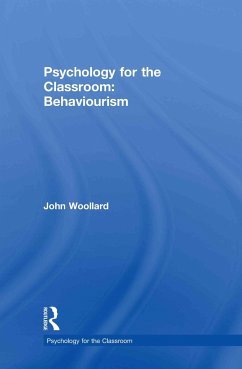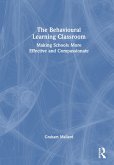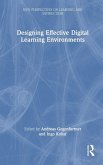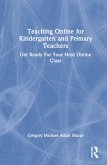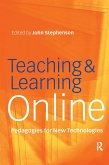John Woollard
Psychology for the Classroom: Behaviourism
John Woollard
Psychology for the Classroom: Behaviourism
- Gebundenes Buch
- Merkliste
- Auf die Merkliste
- Bewerten Bewerten
- Teilen
- Produkt teilen
- Produkterinnerung
- Produkterinnerung
Psychology for the Classroom: Behaviourism provides a broad, unbiased and accessible introduction to behaviourist theory as applied to learning and education in a practical context.
Andere Kunden interessierten sich auch für
![The Behavioural Learning Classroom The Behavioural Learning Classroom]() Graham MallardThe Behavioural Learning Classroom176,99 €
Graham MallardThe Behavioural Learning Classroom176,99 €![Designing Effective Digital Learning Environments Designing Effective Digital Learning Environments]() Designing Effective Digital Learning Environments197,99 €
Designing Effective Digital Learning Environments197,99 €![The Power of Role-Based E-Learning The Power of Role-Based E-Learning]() Sandra WillsThe Power of Role-Based E-Learning198,99 €
Sandra WillsThe Power of Role-Based E-Learning198,99 €![Teaching Online for Kindergarten and Primary Teachers Teaching Online for Kindergarten and Primary Teachers]() Gregory Michael Adam MacurTeaching Online for Kindergarten and Primary Teachers176,99 €
Gregory Michael Adam MacurTeaching Online for Kindergarten and Primary Teachers176,99 €![AI and the Future of Education AI and the Future of Education]() Priten ShahAI and the Future of Education26,99 €
Priten ShahAI and the Future of Education26,99 €![Building the Innovation School Building the Innovation School]() T Philip NicholsBuilding the Innovation School121,99 €
T Philip NicholsBuilding the Innovation School121,99 €![Teaching & Learning Online Teaching & Learning Online]() Teaching & Learning Online197,99 €
Teaching & Learning Online197,99 €-
-
-
Psychology for the Classroom: Behaviourism provides a broad, unbiased and accessible introduction to behaviourist theory as applied to learning and education in a practical context.
Hinweis: Dieser Artikel kann nur an eine deutsche Lieferadresse ausgeliefert werden.
Hinweis: Dieser Artikel kann nur an eine deutsche Lieferadresse ausgeliefert werden.
Produktdetails
- Produktdetails
- Verlag: Taylor & Francis
- Seitenzahl: 144
- Erscheinungstermin: 21. Juni 2010
- Englisch
- Abmessung: 234mm x 156mm x 10mm
- Gewicht: 381g
- ISBN-13: 9780415493987
- ISBN-10: 0415493986
- Artikelnr.: 29925308
- Herstellerkennzeichnung
- Libri GmbH
- Europaallee 1
- 36244 Bad Hersfeld
- gpsr@libri.de
- Verlag: Taylor & Francis
- Seitenzahl: 144
- Erscheinungstermin: 21. Juni 2010
- Englisch
- Abmessung: 234mm x 156mm x 10mm
- Gewicht: 381g
- ISBN-13: 9780415493987
- ISBN-10: 0415493986
- Artikelnr.: 29925308
- Herstellerkennzeichnung
- Libri GmbH
- Europaallee 1
- 36244 Bad Hersfeld
- gpsr@libri.de
John Woollard is Lecturer in Information Technology Education in the School of Education at the University of Southampton. He has previously taught in both primary and secondary schools. He now researches teaching and learning with computers.
Chapter 1. Introduction The language of behaviourism Post-millennium views
of behaviourism The people of behaviourism Refuting the critics of
behaviourism The nature of behaviourism Behaviourism is... Summary
Activities Chapter 2. Research Research with animals Repetition and rote
learning Learning from example Behaviour modification under scrutiny
Providing models for behaviour Self-participation in behaviour change The
impact of reward and praise Summary Activities Chapter 3. Theory Classical
conditioning Stimulus, response and consequence Operant conditioning and
schedules of reinforcement Observational learning by modelling behaviour
Punishment, impact and alternatives Verbal behaviour and dealing with
language Summary Activities Chapter 4. Pedagogy The characteristics of a
behaviourist pedagogy Behaviour modification through positive reinforcement
Creating a curriculum Enhancing the interventions Avoiding the limitations
Reducing unwanted behaviours Summary Activities Chapter 5. Strategies
Strategies of a behaviourist teacher House points and the lottery draw
Basic skills; basic methods Shaping and modelling in ICT teaching SEAL,
sanctuary and self-efficacy Teacher training, social engagement Improving
the learning environment Computerisation of the curriculum The challenging
class Summary Activities References Index
of behaviourism The people of behaviourism Refuting the critics of
behaviourism The nature of behaviourism Behaviourism is... Summary
Activities Chapter 2. Research Research with animals Repetition and rote
learning Learning from example Behaviour modification under scrutiny
Providing models for behaviour Self-participation in behaviour change The
impact of reward and praise Summary Activities Chapter 3. Theory Classical
conditioning Stimulus, response and consequence Operant conditioning and
schedules of reinforcement Observational learning by modelling behaviour
Punishment, impact and alternatives Verbal behaviour and dealing with
language Summary Activities Chapter 4. Pedagogy The characteristics of a
behaviourist pedagogy Behaviour modification through positive reinforcement
Creating a curriculum Enhancing the interventions Avoiding the limitations
Reducing unwanted behaviours Summary Activities Chapter 5. Strategies
Strategies of a behaviourist teacher House points and the lottery draw
Basic skills; basic methods Shaping and modelling in ICT teaching SEAL,
sanctuary and self-efficacy Teacher training, social engagement Improving
the learning environment Computerisation of the curriculum The challenging
class Summary Activities References Index
Chapter 1. Introduction The language of behaviourism Post-millennium views
of behaviourism The people of behaviourism Refuting the critics of
behaviourism The nature of behaviourism Behaviourism is... Summary
Activities Chapter 2. Research Research with animals Repetition and rote
learning Learning from example Behaviour modification under scrutiny
Providing models for behaviour Self-participation in behaviour change The
impact of reward and praise Summary Activities Chapter 3. Theory Classical
conditioning Stimulus, response and consequence Operant conditioning and
schedules of reinforcement Observational learning by modelling behaviour
Punishment, impact and alternatives Verbal behaviour and dealing with
language Summary Activities Chapter 4. Pedagogy The characteristics of a
behaviourist pedagogy Behaviour modification through positive reinforcement
Creating a curriculum Enhancing the interventions Avoiding the limitations
Reducing unwanted behaviours Summary Activities Chapter 5. Strategies
Strategies of a behaviourist teacher House points and the lottery draw
Basic skills; basic methods Shaping and modelling in ICT teaching SEAL,
sanctuary and self-efficacy Teacher training, social engagement Improving
the learning environment Computerisation of the curriculum The challenging
class Summary Activities References Index
of behaviourism The people of behaviourism Refuting the critics of
behaviourism The nature of behaviourism Behaviourism is... Summary
Activities Chapter 2. Research Research with animals Repetition and rote
learning Learning from example Behaviour modification under scrutiny
Providing models for behaviour Self-participation in behaviour change The
impact of reward and praise Summary Activities Chapter 3. Theory Classical
conditioning Stimulus, response and consequence Operant conditioning and
schedules of reinforcement Observational learning by modelling behaviour
Punishment, impact and alternatives Verbal behaviour and dealing with
language Summary Activities Chapter 4. Pedagogy The characteristics of a
behaviourist pedagogy Behaviour modification through positive reinforcement
Creating a curriculum Enhancing the interventions Avoiding the limitations
Reducing unwanted behaviours Summary Activities Chapter 5. Strategies
Strategies of a behaviourist teacher House points and the lottery draw
Basic skills; basic methods Shaping and modelling in ICT teaching SEAL,
sanctuary and self-efficacy Teacher training, social engagement Improving
the learning environment Computerisation of the curriculum The challenging
class Summary Activities References Index

